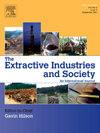Intra-firm variations of technological capabilities accumulation paths: The Brazilian mining industry
IF 4.3
2区 社会学
Q2 ENVIRONMENTAL STUDIES
Extractive Industries and Society-An International Journal
Pub Date : 2025-04-25
DOI:10.1016/j.exis.2025.101672
引用次数: 0
Abstract
Much progress has been made since the 1970s in terms of understanding the technological capabilities accumulation process at the firm level in emerging economies. However, there are still few studies that deal with the nature and dynamics of technological capabilities accumulation trajectories in natural resources industries. This contributes to a debate, still inconclusive but mainly with a negative view, about the role of industries related to natural resources for economic, industrial, and technological development. So, here, we explored technological capabilities accumulation paths in natural resources industries in the context of emerging economies. To achieve this goal, the research draws on a qualitative and inductive research design on primary evidence based on extensive fieldwork. This research design is operated from a single in-depth case study at mining firm Vale between 1940 - 2020, within three major technology areas: prospecting and mineral exploration, mining, and mineral processing. Through the implementation of this strategy, the research found distinct paths between the three areas: (i) in mineral prospecting and research, there was a technological follower path that achieved global leadership position in innovation and production; (ii) mining area also showed up a technological follower path that achieves global leadership position in innovation and production, however, with late accumulation of technological capabilities; and (iii) the area of mineral processing showed an early entrance of a world leader in innovation and production from the creation of a distinct path already mapped by global leaders. The technological capabilities accumulation paths became similar in 2011 when the three areas presented a world leader in innovation. The findings contribute to understanding the accumulation of technological capabilities process in mining firms, offering detailed empirical insights and highlighting the industry's potential for significant innovations.
技术能力积累路径的企业内部变化:巴西采矿业
自20世纪70年代以来,在理解新兴经济体企业层面的技术能力积累过程方面取得了很大进展。然而,关于自然资源产业技术能力积累轨迹的性质和动态的研究仍然很少。这导致了一场关于与自然资源有关的工业在经济、工业和技术发展中的作用的辩论,尽管辩论尚未得出结论,但主要持消极观点。因此,在这里,我们探讨了新兴经济体背景下自然资源行业的技术能力积累路径。为了实现这一目标,本研究采用了基于广泛田野调查的定性和归纳研究设计。该研究设计基于1940年至2020年间Vale矿业公司的单一深度案例研究,涉及三个主要技术领域:勘探和矿产勘探、采矿和矿物加工。通过这一战略的实施,研究发现了三个领域之间的明显路径:(i)在矿产勘探和研究方面,有一条技术跟随者路径,在创新和生产方面取得了全球领先地位;矿区也呈现出技术跟随者路径,在创新和生产上取得全球领先地位,但技术能力积累较晚;(三)矿物加工领域显示了一个世界领先者在创新和生产方面的早期进入,这是一个由全球领导者已经绘制的独特路径。2011年,这三个领域的技术能力积累路径相似,在创新方面处于世界领先地位。研究结果有助于理解矿业公司技术能力积累过程,提供详细的实证见解,并突出了该行业重大创新的潜力。
本文章由计算机程序翻译,如有差异,请以英文原文为准。
求助全文
约1分钟内获得全文
求助全文
来源期刊

Extractive Industries and Society-An International Journal
ENVIRONMENTAL STUDIES-
CiteScore
6.60
自引率
19.40%
发文量
135
 求助内容:
求助内容: 应助结果提醒方式:
应助结果提醒方式:


